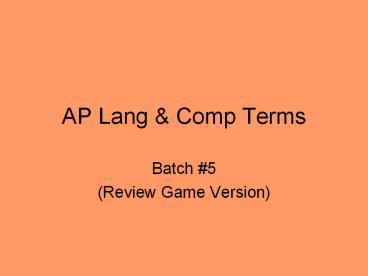AP Lang & Comp Terms - PowerPoint PPT Presentation
1 / 51
Title:
AP Lang & Comp Terms
Description:
AP Lang & Comp Terms Batch #5 (Review Game Version) #1 Identify the literary term/device: The perspective that a narrative takes toward the events it describes. – PowerPoint PPT presentation
Number of Views:123
Avg rating:3.0/5.0
Title: AP Lang & Comp Terms
1
AP Lang Comp Terms
- Batch 5
- (Review Game Version)
2
1
- Identify the literary term/device
- The perspective that a narrative takes toward the
events it describes.
3
Answer 1
- Point of view
4
2
- Identify the literary device being used
- The chairs of the English departments at Harvard,
Cambridge, and Oxford all agree that Shakespeare
was almost certainly the author of the plays that
bear his name.
5
Answer 2
- Expert opinion
- The citation of accredited authorities in support
of an argument
6
3
- Identify the literary term/device
- The misplacement of a person, occurrence, custom,
or idea in time also sometimes refers to an
individual or thing that is incorrectly placed in
time.
7
Answer 3
- Anachronism
8
4
- Identify the literary term/device
- The moment of greatest intensity in a text, or
the major turning point in the plot.
9
Answer 4
- climax
10
5
- Identify the literary term/device
- A cleansing or purification of ones emotions
through art.
11
Answer 5
- catharsis
12
6
- Identify the literary term/device
- Ideas, facts, or allegations spread to persuade
others to support ones cause or to go against
the opposing cause.
13
Answer 6
- propaganda
14
7
- Identify the literary device being used
- I came to bury Caesar, not to praise him.
- (Shakespeare, Julius Caesar, 3.2.71)
15
Answer 7
- Antithesis
- The contrasting of ideas by the use of parallel
structure in phrases or clauses
16
8
- Identify the literary term/device
- A humorous and often satirical imitation of the
style or particular work of another author.
17
Answer 8
- parody
18
9
- Identify the literary device being used
- The crown carries many responsibilities.
19
Answer 9
- Metonymy
- A figure of speech in which something is referred
to by one of its attributes.
20
10
- Identify the literary term/device
- In writing, a practice or principle (such as a
rule of spelling, grammar, or usage), that is
accepted as true or correct.
21
Answer 10
- Convention
22
11
- Identify the literary term/device
- A narrative in which literal meaning corresponds
directly with symbolic meaning.
23
Answer 11
- Allegory
24
12
- Identify the literary term/device
- A word or idea that can be understood in multiple
ways frequently refers to the condition of being
obscure or difficult to understand.
25
Answer 12
- Ambiguity
26
13
- Identify the literary device being used
- Barber, baby, bubbles, and a bumblebee
- (Dr. Seuss, Dr. Seusss ABC An Amazing Book)
27
Answer 13
- Alliteration
- The repetition of similar sounds, usually
consonants, at the beginning of words.
28
14
- Identify the literary term/device
- In an argument, a person cited because his or her
opinion carries special weight or credibility.
29
Answer 14
- Authority
30
15
- Identify the literary term/device
- Any composition not written in verse
31
Answer 15
- Prose
32
16
- Identify the literary term/device
- A yearning for the past or for some condition or
state of existence that cannot be recovered.
33
Answer 16
- Nostalgia
34
17
- Identify the literary device being used
- Its nothing. Im just bleeding to death is all.
35
Answer 17
- Litotes
- Deliberate understatement, in which an idea or
opinion is often affirmed by negating its
opposite.
36
18
- Identify the literary device being used
- Ive told you this a million times already.
37
Answer 18
- Hyperbole
- Excessive overstatement or conscious exaggeration
of fact.
38
19
- Identify the literary term/device
- A style in which the narrator reports neutrally
on the outward behavior of the characters but
offers no interpretation of their actions or
their inner states.
39
Answer 19
- Third person objective point of view
- (objective narration)
40
20
- Identify the literary term/device
- A work that exposes to ridicule the shortcomings
of individuals, institutions, or society, often
to make a political point.
41
Answer 20
- satire
42
21
- Identify the literary term/device
- Specific word choice used in a piece of writing,
often chosen for effect but also for correctness
and clarity.
43
Answer 21
- diction
44
22
- Examples of this literary device
- Same difference
- Jumbo shrimp
- Soft rock
45
Answer 22
- Oxymoron
- The association of two contradictory terms
46
23
- Identify the literary term/device
- The location of a narrative in time and space
helps to create mood or atmosphere.
47
Answer 23
- Setting
48
24
- Identify the literary term/device
- An extraordinary use of language to achieve a
certain effect on an audience. Some examples are
chiasmus, parallelism, rhetorical question, and
synecdoche.
49
Answer 24
- Rhetorical device
50
25
- Identify the literary term/device
- In the context of writing and literature, this
term refers to the reading public or to a
specific group of intended readers.
51
Answer 25
- Audience































